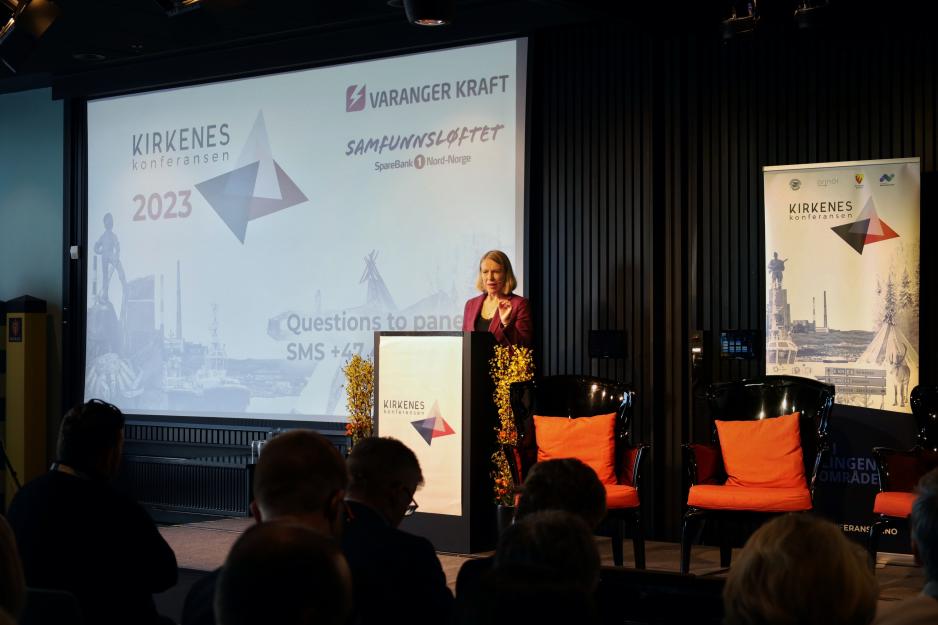Barely Anyone Talks of Low Tension in the Arctic Anymore

Norwegian MFA Anniken Huitfeld at the Kirkenes Conference with a newly written manuscript. (Photo: Astri Edvardsen, High North News)
(Commentary) Few have attended as many lectures and seen as many PowerPoint presentations about the Arctic and the High North as I have throughout the years. Often quite bland and almost on autopilot. During the last few months, however, a significant change has taken place.
That is due to Russia's war against Ukraine. The slogan, which has had a persistent spot in every presentation, has been deleted from the script.
As late as the middle of November last year, the Norwegian Minister of Foreign Affairs Anniken Huitfeldt used the slogan "High North – Low Tension," as she stood in front of the audience at the annual Russia Conference in Oslo. Already more as an aim, than reality.
Deleted after three months
When she gave a speech at the Kirkenes Conference barely three months later, this permanent feature of every Arctic MFA presentation was tucked away in an archive in the Ministry of Foreign Affairs in Oslo.
That is not accidental. A solid portion of realpolitik is behind the change.
It is no longer possible to claim that the High North and the Arctic are areas of low military tension. Even as an aim, it is so far removed from today's situation that is becomes almost meaningless.
It becomes almost meaningless.
We who live in the north see it with our own eyes almost every day. And those of you who read High North News at a distance or other international newspapers with its eyes directed northward will find news updates or analyses describing a powerful militarization of the High North daily.
A part of everyday life
On both sides of the border with Russia on one side, and Finland and Norway on the other side, military exercises are part of everyday life. The amount of weapons is increasing and the same can be said for the number of soldiers in uniform, at least on the western side.
The slogan "High North – Low Tension describes the balance between deterrence and reassurance. Today, the scale is tipped in the direction of pure deterrence.
Another, but important point, about this balance, is what is called symmetry. Deterrence works best when both parties balance their military initiatives in proportion to each other. If the balance is disturbed, a situation arises in which one of the parties may feel more threatened than deterred, and the situation can get out of control.
Fateful game about the future of the Arctic.
Looking for light
I have the habit of looking for light, also when the sky is colored dark.
That is why I emphasize that voices exist also among the Armed Forces' own analysts, albeit not in the public domain, who question how far the military escalation in the north can go before it has gone too far.
I also notice that the forces on the Western side who are fighting for a total isolation of Russia are losing to reality.
This was seen most recently as a Russian fighter jet collided with an American drone over the Black Sea a few days ago. Basically, an event more feared than anything else, precisely because such possibly unintentional confrontations are pointed to as one of the most relevant reasons for why we can move from a "cold" to a "warm" war.
The contact is there
When this did not happen, that is an example of both political and military contact between the east and the west. In the meeting with the US authorities, the Russian ambassador to the US did not apologize for Russia's actions, but still described the conversations with the Americans as constructive.
Norway plays a main role in a whole other, fateful game about the future of the Arctic. Right now, a fight is being fought tooth and nail to bring about a transition between the current Russian chairmanship of the Arctic Council and the future Norwegian one.
Today, no one can guarantee a successful transition, that the Arctic Council will continue as a central and operative organization in the north, but the work shows another important point of contact between east and west.
Any escalation of Western military activity does not promote low tension.
Norway and Russia also managed to come to an agreement in the annual fishery negotiations not long ago.
Thus far, we have been able to balance the crucial energy cooperation between Norway and Russia in the High North.
Time to slow down?
All the way down to the local level in the north, a political game of international significance is taking place. When the border municipality to Russia, Sør-Varanger, will shortly decide on a restriction on the freedom of movement for Russian seafarers, it has significance beyond the municipality's borders.
It is demanding, both politically and in terms of values, to justify the need to limit the freedom of movement for Russians with legitimate access to a very limited part of Kirkenes center.
In Tromsø, which also receives Russian fishing vessels, Russians are allowed to move freely within the municipality as long as they have their seaman's passport.
That one cannot talk of the High North as an area of low tension, is due to Russia's brutal attack on Ukraine. But that does not mean that all escalation of the military activity on the western side promotes low tension. Perhaps rather the opposite.
Above all, it means that the channels between east and west must be kept open to avoid the last remnant of reassurance being completely replaced by deterrence.
Also read
This commentary was originally published in Norwegian and has been translated by Birgitte Annie Molid Martinussen.


